|
The 2006 Formula
One World Championship gets underway this weekend in
Bahrain, with the Sakhir circuit having the honour of
hosting the opening round, as the city of Melbourne is busy
with the Commonwealth Games. This is the third year that
Bahrain has hosted a Grand Prix, so the track itself should
hold few surprises for the teams, especially as Scuderia
Ferrari Marlboro conducted a long test session here in
February.
However, the Prancing Horse and the ten other teams will all
be facing the challenges of changes to the technical and
sporting regulations. As usual, these have been introduced
by the FIA with the aim of reducing costs, reducing speeds
on safety grounds and improving the show for the public.
This year the main changes compared to 2005 are as follows:
firstly, on the technical rule front, cars now run 2.4 litre
V8 engines (although one team, Scuderia Toro Rosso is taking
up the approved option of running a restricted-power version
of the previous 3 litre V10.) Engines must still last two
entire race weekends so the biggest changes to the sporting
regulations concern the way qualifying is run and the fact
that tyres can now, once again, be changed during the race.
The Scuderia's Sporting Director, Stefano Domenicali
explains the effect of these new rules and how they impact
on the team's approach to qualifying and the race. "With the
tyre situation, we will have seven sets of dry tyres of two
different specifications that we are allowed to use over a
race weekend. There is no longer a requirement to formally
nominate one specification of tyre after a certain point in
the weekend as was the case up until now. However, we must
use the same specification of tyre for all of qualifying and
the race."
If the rules of parc ferme remain essentially the same, with
work on the cars restricted, for 2006 these rules are
different when it comes to fuel and tyres. "The rules
concerning fuel are different because they are now linked to
the qualifying procedure," says Domenicali, "and tyres,
because you can use as many tyres as you want now for the
race. Qualifying will be divided into 3 parts: the first
part of 15 minutes followed by a 5 minute break, a second
part of 15 minutes followed by a 5 minute break and the
third and final part of 20 minutes."
|
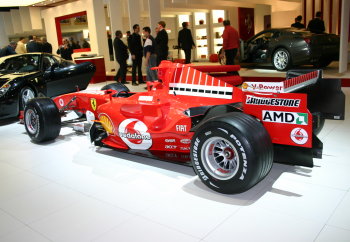
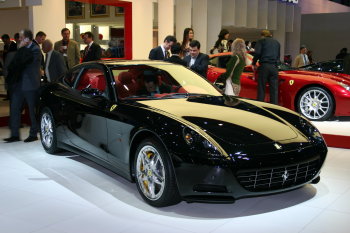
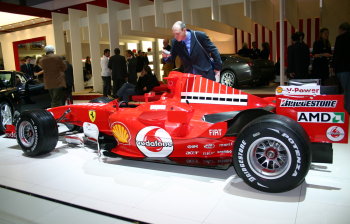
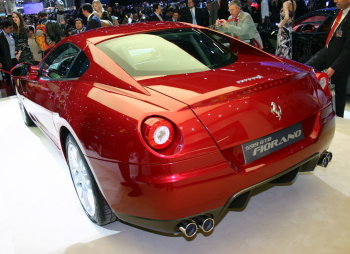 |
|
As is the custom
Ferrari F1's chassis has joined its road-going
cousins, including the 612 Scaglietti and the 599GTB
Fiorano on the occasion of its world debut, at the
Geneva International Motor Show this week. |
|
|
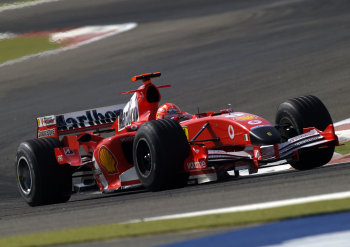
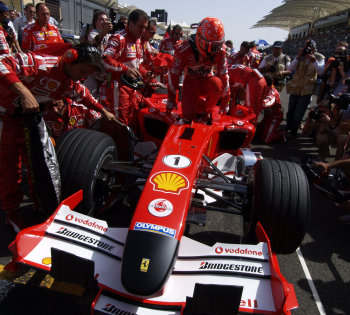 |
|
Despite starting from
the second row of the grid with the new F2005 in
Bahrain last year, Scuderia Ferrari's Michael
Schumacher failed to score any points. |
|
|
The race weekend
also runs to a slightly different timetable this year: the
Friday programme remains the same, but on Saturday, there
are no longer the two 45 minute free practice session, but
just one hour from 11 to 12, with qualifying from 2 to 3.
"At two o'clock, the first part of qualifying begins and
that signals the start of parc ferme conditions, with the
exception of fuel and tyres," explains Domenicali. "In the
first 15 minutes all 22 cars will run on track. Then the
slowest 6 cars take no further part in the session. The same
procedure will apply in the second part. At the end of these
two periods, these 12 cars now have their places confirmed
on the last 12 places on the grid. In these two parts you
can run whatever fuel load you like, normally a light load
to set the quickest time possible of course and with the
tyres that you want. There is no restriction on the number
of sets of tyres or the number of laps you can complete.
Then before the start of the third part, with the last ten
cars, it is compulsory to go back to the restriction in
terms of fuel. Because time between the three parts of the
session is so tight, you will be allowed to refuel using the
normal race refuelling rig. There is now a system in place
to give you back the fuel you use in this last part of the
session, so that you start the race on Sunday with the same
fuel load with which you began the final part of qualifying
on Saturday. It is calculated by a formula published by the
FIA prior to the start of the event. The FIA will make an
estimation of kilos per lap they will give back to you.
Assuming a car did 10 laps in the final part of qualifying
and the FIA states that a lap of this circuit uses 3 kilos
per lap, then you have to put back a total of 30 kilos on
Sunday morning in parc ferme."
It is a complicated system, rendered more so by the fact
that not all the drivers will be running the same number of
laps in this final session, therefore the amount of fuel to
be added can be different for various cars. Domenicali
believes this new qualifying format will be exciting, as
long as it is explained properly to spectators and TV
viewers. "Otherwise it will be very difficult to understand
what is going on, especially when you consider that those
people who were eliminated after the first two parts of
qualifying were running on minimum fuel and they may have
set times in Q1 and Q2 that are quicker than pole position!
But it should be more spectacular as it is a long time since
drivers have all been on track at the same time for
qualifying and I am sure there will be some interesting and
controversial moments."
Domenicali believes these new qualifying rules will also
impact on race strategy. "The twelve cars at the back of the
grid are free to refuel with any quantity of fuel on Sunday
prior to 12.30 for a 2 o'clock race. They can base their
fuel calculations on the performance they saw achieved by
the ten cars in the top ten grid positions as these drivers
were running race fuel loads. This means we can have a very
mixed race in the first and second stints of a race." The
other change to strategy, compared to 2005, is down to the
new tyre rules. "The effect on strategy of being able to
change tyres in the race once again is very relevant,"
reckons Domenicali. "You can decide to use a very aggressive
strategy if you have good tyre performance and in my opinion
that will improve the quality of the race. With no tyre
changes, you had to manage tyres in a different way. Now we
can change whenever we want and, allowing for the number of
tyres at your disposal, you can be as aggressive as you
want. I'm sure it will improve the show."
|
|
|
|
![]()
![]()